
A diver's guide to finding the smartest animals on the reef

An array of powerful suction discs on flailing tentacles snare unsuspecting prey and draw it to a sharp parrot-shape beak. With a single bite, venom is released, paralyzing the victim. As the attacker feeds, three hearts pump blue blood through its shape-shifting body, which seems to disappear by taking on the colors and patterns of the surroundings. This creature displays native cunning; it adapts and learns. No, it's not an alien dreamed up by a science fiction writer. It's real, and divers know where to find it.
We're talking, of course, about the octopus, the most intriguing member of the mollusk family. There are more than 300 known species of octopus in the oceans of the world, ranging in size from less than an inch across to more than 30 feet between outstretched tentacles. Here are six varieties you are likely to run into on dives sites in the Caribbean, Pacific or the Indian Ocean.
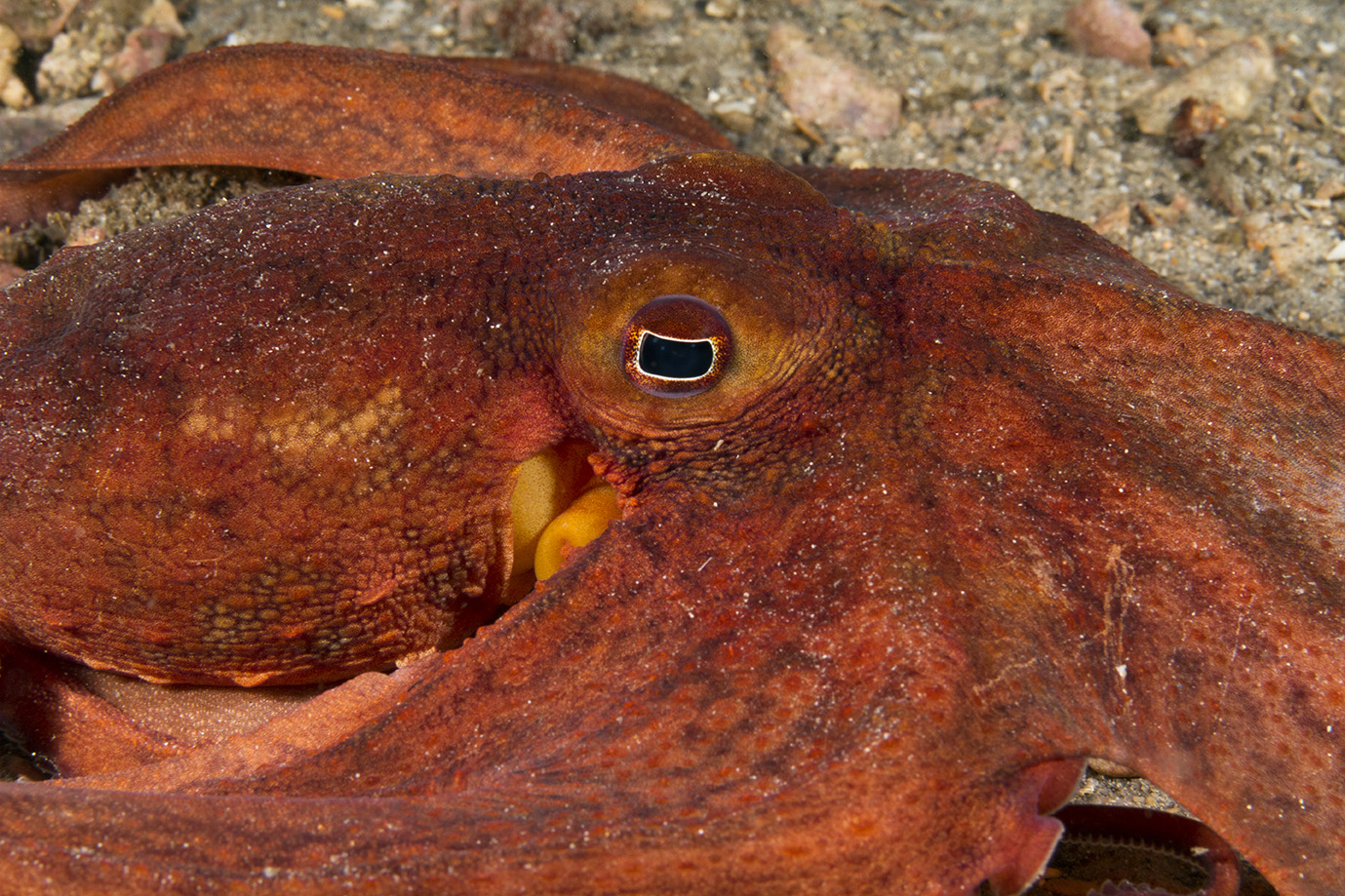
Caribbean Reef Octopus
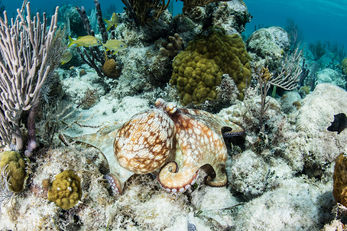
This mid-sized octopus is common throughout the Bahamas and Caribbean, but most are likely to be seen on night dives. These shy, reclusive creatures stay hidden within deep recesses of the reef by day, then emerge from their lair when the sun goes down to prowl the bottom, hunting for food. They mostly eat crustaceans like shrimps and crabs, but will also not pass up a fish dinner should one come within range of its tentacles.
What puts this octopus at the top of the must-see list for divers are the kaleidoscopic color changes they will often display when revealed by an underwater light. In a flash, a reef octopus can switch from an iridescent blue and green to stark white, then deep red and back to its original coloration. Some octopus will change their appearance a thousand times over the course of a day. This ability often serves as a form of communication, warning off would-be predators. That's what's happening to the octopus in this photo, which is turning red to tell us "go away, I don't like cameras!"

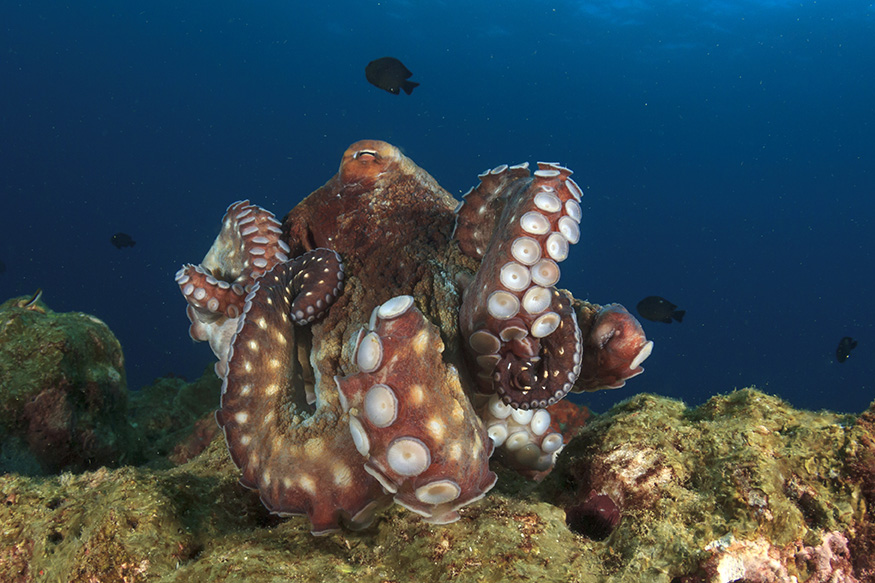
Common Atlantic Octopus
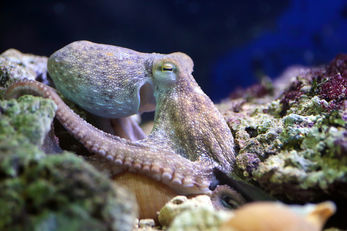
The most widespread species of octopus in the Caribbean and tropical Atlantic is, for lack of a better name, the common octopus. Telling a common apart from the reef is not easy. The best advice is to look at the length of their arms. A common’s arms will be about 3 to 4 times longer than their body, while a reef’s arms are considerably longer, running 4 to 6 times their body length. Then there is something a common does better than a reef. In addition to rapid color changes, they can also alter the pattern of their skin to match their surroundings, making them marvels at the disappearing act.
The common octopus prefers sea grass, sand and rubble bottoms rather than coral reefs. They also love to take up residence inside discarded conch shells, empty cans, glass jars and bottles. This highly intelligent hunter uses its morphing talent to provide protection from would-be predators and to also stalk prey undetected. In a split second, the octopus can deploy its muscular tentacles to draw the prey within reach of the sharp beak.

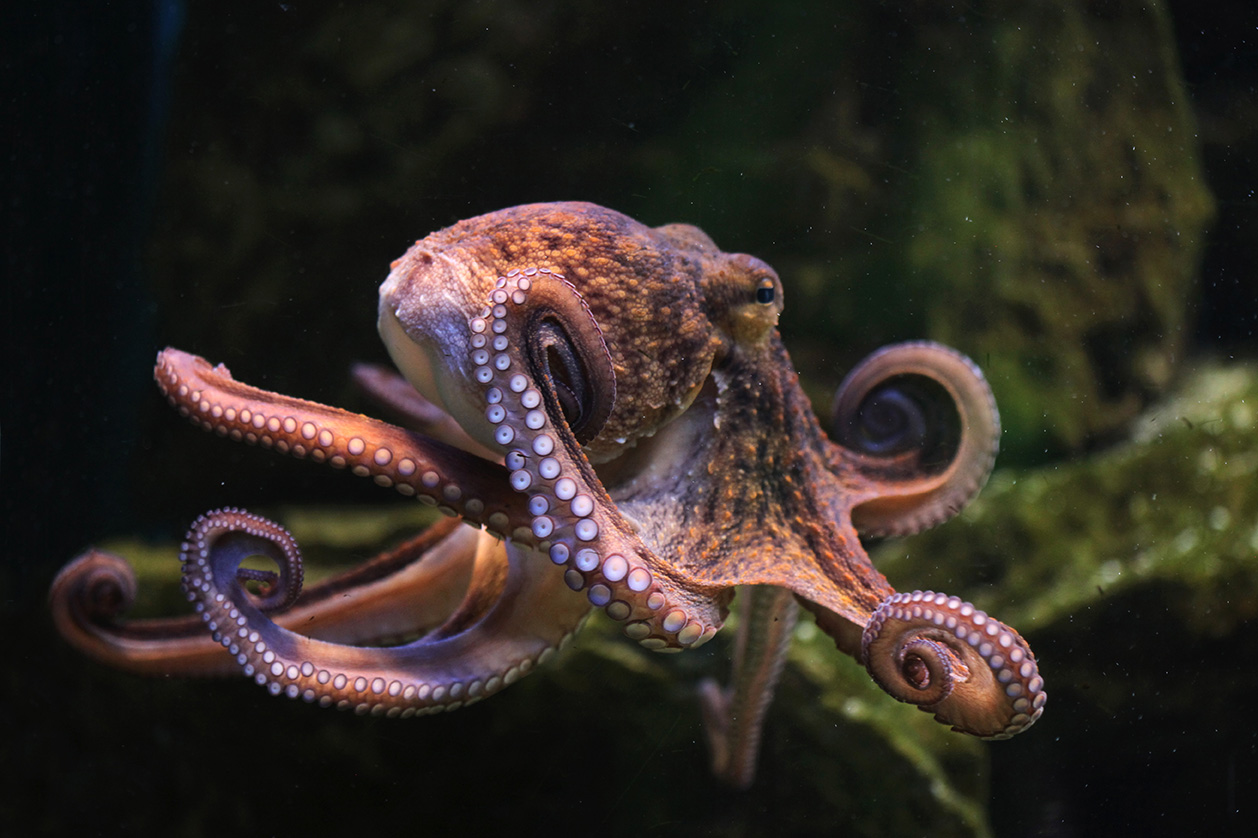
The Blue, a.k.a Day Octopus

When diving a reef in the tropical Pacific and the Indian Ocean, you may spot a large octopus perched on a coral head, serenely watching the world go by. This is probably a day octopus. You might hear a divemaster refer to it as a Cyane's octopus or a big blue octopus, but that's just different names for the same animal. Unlike its nocturnal relatives, this species is typically seen during daylight hours. And though it is sometimes called the big blue octopus, it more often sports a mottled or spotted pattern of brown, tan and red.
Days are the largest octopus in the region, growing to lengths of 30 inches. They are also the most active, prowling the reef and probing into crevices for prey such as crabs and small fish. These octopuses are usually loners, so should you find two together, you may have stumbled upon a pair in courtship or in the process of battle. In either case, there is sure to be a show as both sides will go through a broad series of color changes.

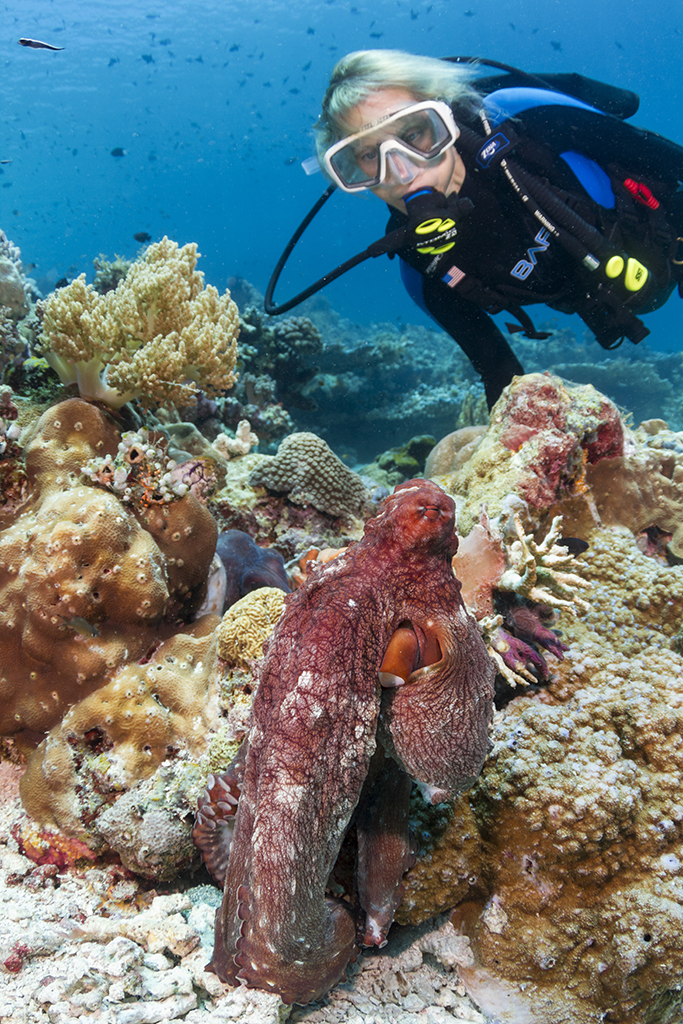
Coconut Octopus
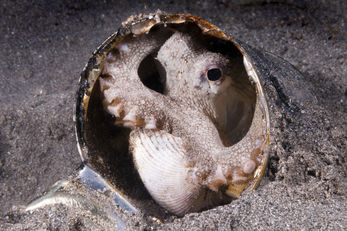
If you are on a muck dive in places like the Philippines, Indonesia or New Guinea and happen to spot what looks like an empty shell walking across the sand on tiny legs, you’re not hallucinating. Closer inspection will likely reveal a coconut octopus, making rather ingenious use of a discarded item that they can use as a helmet. Not much larger than your hand, this sly little cephalopod lives on desert-like sea bottoms that provide no shelter from predators. To survive, the coconut octopus collects shells or other hard shield-like materials, which it carries with it like body armor.
Marine scientists label this shell-carrying behavior as “tool use,” because the acquired objects are not used for full-time habitation the way a hermit crab moves into a discarded shell, but instead are carried about in anticipation of a need. When threatened, the Coconut octopus might flip a pair of shells around its body, leaving several arms extended as it comically scurries away like a cartoon character.


Blue-ringed Octopus

The blue-ringed octopus has an infamous reputation as one of the most toxic creatures in the sea. When provoked, its skin will flash with a series of brilliant neon blue rings. Any unlucky assailant who ignores this warning may receive a potent dose of the toxin known as Tetrodotoxin. A mere milligram of this poison can kill, and there is no known antidote. But before you run screaming from the water, know that very few humans are actually bitten by a blue-ringed octopus, and it's usually a case of self-defense from a diver harassing the animal.
The blue-ringed prefers shallow waters along the top of a reef or in a near-shore rubble field. They’re daytime feeders, hunting for shrimp, crabs and small fish, using a far lesser dosage of poison to subdue their prey. The blue-ringed's normal coloration ranges from dull yellow to brown, in patterns that blend well into their surroundings. This makes them quite difficult to spot. The vivid rings kick in only when the octopus knows it has been discovered or feels threatened, and that's when you know to keep your hands to yourself.
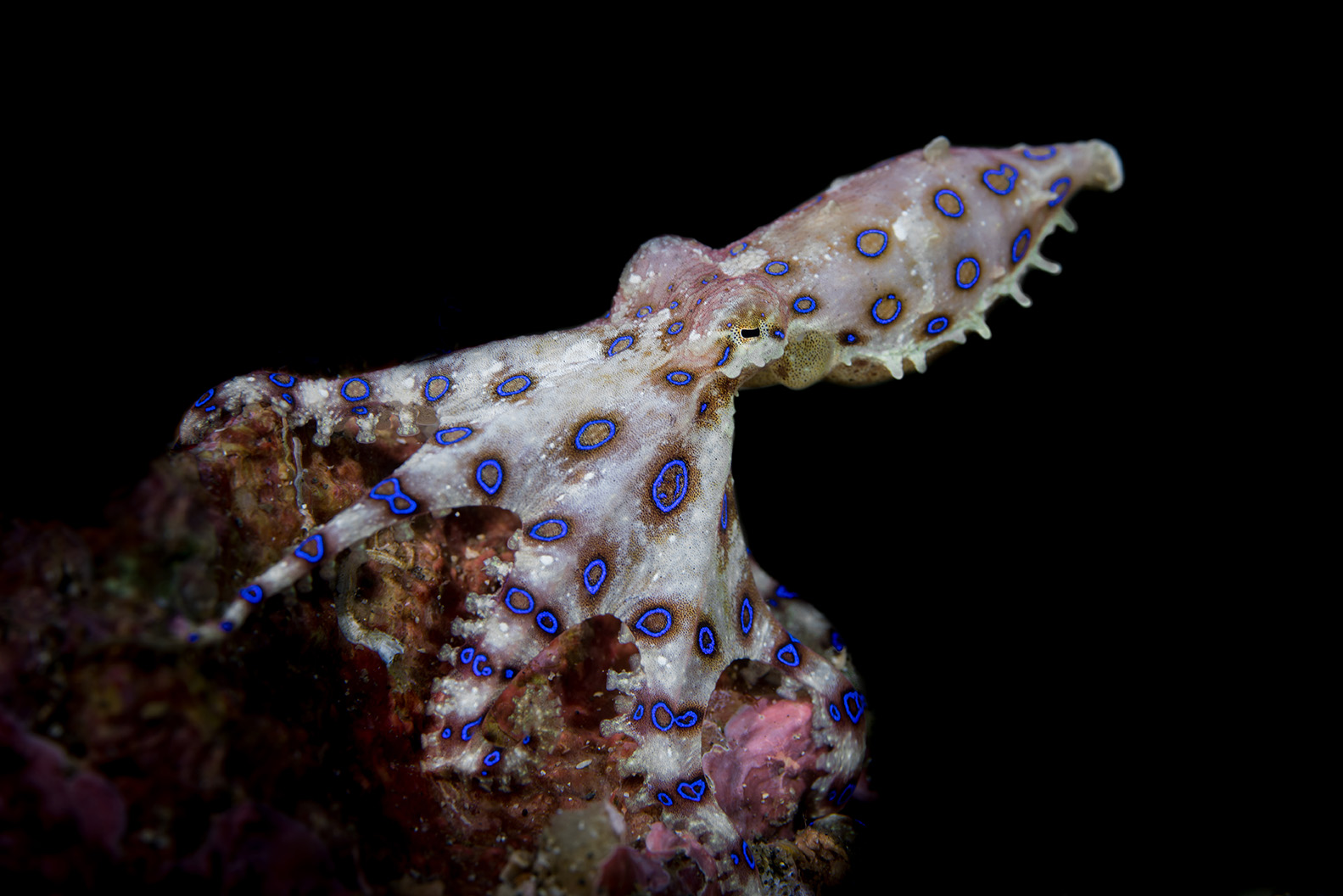

Mimic Octopus
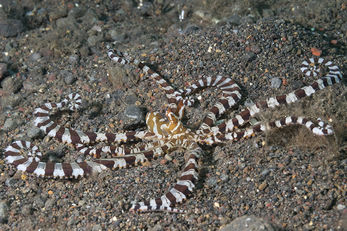
Sometimes confused with the similar-looking wonderpus, the mimic octopus has a small, narrow body with seemingly disproportionally long, pencil-thin arms that can grow to a length of about two feet. Both species sport beige to rust coloration with white bands up and down their arms. If you can get close enough to see white spots on the animal's mantle, you'll know it's a wonderpus, not a mimic. Primarily found at night, both species prefer muck environments with soft sandy bottoms, grass beds or rubble.
The feature that sets the mimic apart from the rest of the octopi family is an amazing set of behavioral tricks used to confuse or scare off predators. Mimics can impersonate more than two-dozen different sea creatures, waving their tentacles to create the illusion of a placid sea anemone one moment or a Volitan lionfish the next. They might mimic the profile of a crab walking sideways by stretching two arms out front like claws, or elongate and stretch four arms forward and four back to resemble a banded sea krait slithering across the bottom.
Whether they are out stalking lunch, hiding to avoid becoming dinner or just moving about, an octopus can be hard to spot. But once your eye becomes accustomed to spotting them, you will begin to see these intriguing creatures more and more frequently. And if you don't, you can always ask the local resort dive guide to point one out. Have a camera ready, because you’re in for a show.

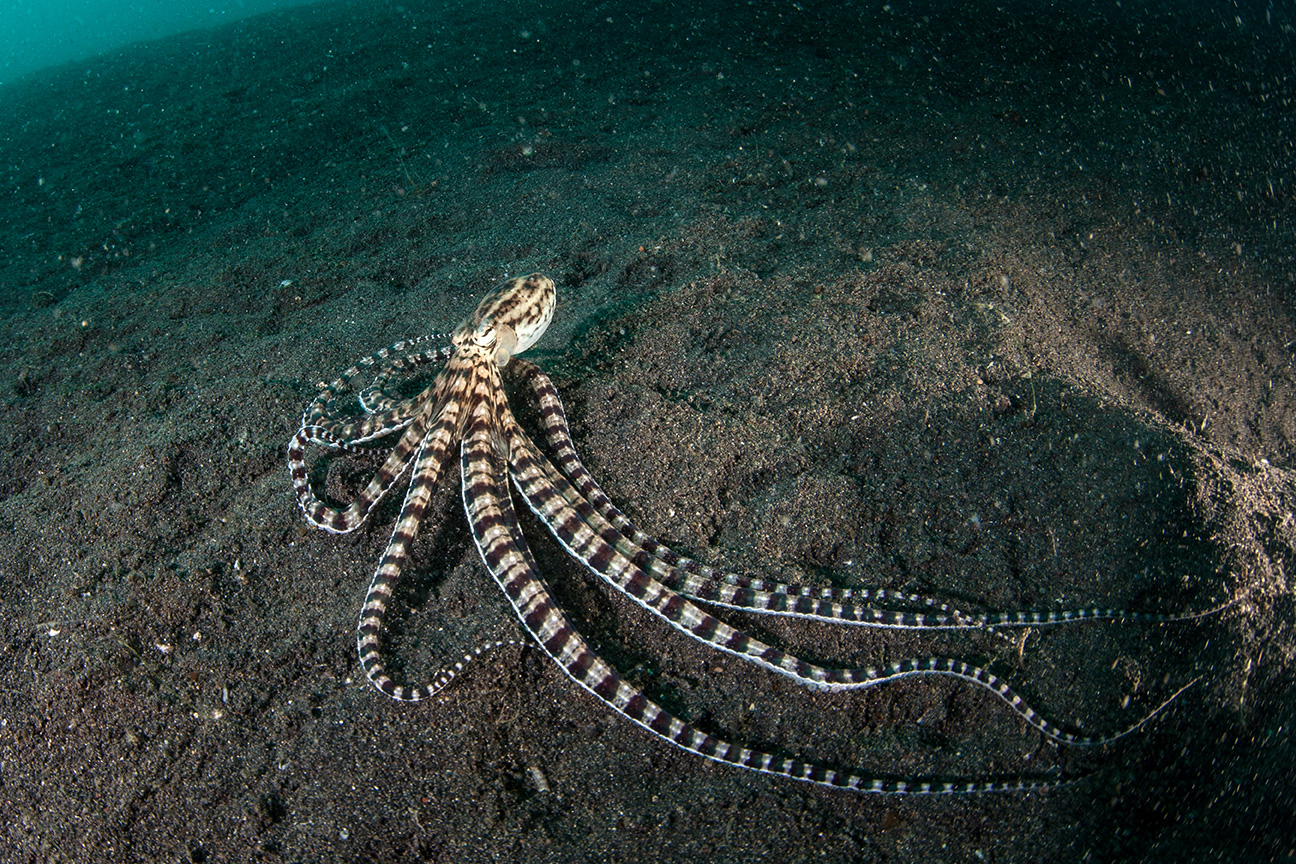
Octo Facts

Here are a few more bits of octopus trivia to share with your dive buddies
About those three hearts: two work exclusively to move blood beyond the octopus’s gills, while the third keeps circulation flowing for the organs. The organ heart actually stops beating when the octopus swims, which is probably why they often crawl rather than swim.
How an octopus sees the world: Rather than change shape to focus, the lenses of an octopus' eyes move in and out like a camera lens. These animals tend to be nearsighted, but they have no blind spot, and seldom miss anything happening nearby. In addition, the pupils of the eye are oriented to the horizontal, regardless of body position. This can be a handy adaptation for a creature that is always morphing its shape.
Once and done: Most octopus has short lives, anywhere from six months to a few years. They only mate once and die soon after. For a mother octopus, her final act is the tiring job of endlessly pumping water over the eggs to keep them clean. She will not take a break to look for food for fear her eggs will be eaten by fish. By the time the eggs hatch, her exhaustion is so complete her life is pretty much over.
Very clever: Octopus have not only shown the ability to use tools but also to learn new tricks. In one experiment, marine scientists put a snack inside a childproof pill bottle, and an octopus was able to get the bottle open in less than five minutes.
Strong but sensitive: The suckers on an octopus' tentacles can manipulate small objects and detect subtle chemical traces and scents, but they are also quite strong. A large octopus can lift objects as heavy as 30 pounds or more.